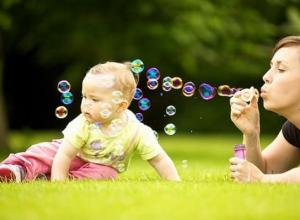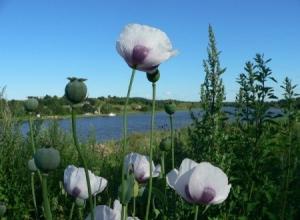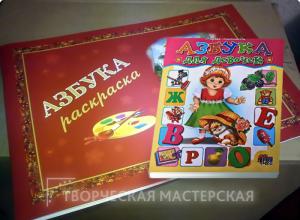Crocheting washcloths for beginners: patterns. My experience of crocheting washcloths with elongated loops Knitted washcloth mitten
Ordinary bathing will turn into a fun activity if such a puppy named Mochalkin settles in your bathroom. It fits easily on your hand, perfectly holds soap suds and immediately performs two functions: a bath accessory and an entertainment item.
In order for such a blue miracle to wink at you from the shower, you should get polypropylene yarn. The choice of color is at your discretion; combinations are encouraged, as in this case. Please note that the body comes in two threads, so stock two skeins at least. To help you, hooks with numbers 5.5 (for the body) and 3 (for everything else), a sewing needle with a fairly wide eye and a burning desire to become the owner of a washbasin puppy.

Like many knitted products, the puppy begins with a set of air loops and closing them into a ring. To make a washcloth easily fit on the hand of an adult woman, thirty-two loops are enough. Next, let’s introduce a couple of notations: let the single crochet be the basic column, and in our case we’ll call the long loops elongated elements.
The puppy stands on three circular rows of basic blue columns.

Then we turn the knitted strip inside out and boldly continue to create in a circle, only we move on to the elongated elements.

From the fourth to the 14th row we do not change the pattern, in the 15th row we evenly reduce the circle by 4 columns, knitting each 7th and 8th element together, and in the 16th, 17th and 18th rows we switch to the base columns and use a white thread to form a collar.

Next, in each circle we combine the basic columns and elongated elements in a ratio of 10 to 18, where ten is the place for the future muzzle, and 18 is the curly back of the head. In this way we make six rows.

From the 25th row we begin decreasing, three circles are completely knitted with elongated elements in this order: 1 decreasing circle after every fourth element, 2 circle - decreasing after every second element, 3 circle - all decreasing. Pull the remaining loops tightly and sew on the wrong side.

Let's move on to the details. We turn our washcloth into a funny little animal: we make ears, an oval nose, a gold medal, and we embroider the eyes with stitches using a regular sewing needle. We work with a single thread.
Mochalkin’s ears are double: the bottom is white, and the top part is shaggy and colored, it can be to match the body or with the addition of other colors from the remnants of yarn. The lower part consists of 20 rotary rows connected from base columns; at the end of each row, do not forget one loop for lifting. So, we start with three basic columns, then, knitting two columns from the left and right edges, we reach 5 basic columns in a row. After three rows, we also add one loop at the edges and finish a couple of rows (5 and 6) on seven basic columns. The seventh row becomes longer by two more columns; row 11 inclusive, we count 9 elements in rows. In the twelfth row we make a similar increase along the edges and form the next pair of rows from 11 columns. We expand the fifteenth row to 13 columns, carry out two turns without changes and proceed to rounding the ear. We bring the number of base columns to 9, performing in order: decrease, two base columns, decrease, two base columns, decrease, 1 base column, decrease. The penultimate turn is designed for 9 columns, and in the last one we knit each pair of columns together and stop there. We perform the colored outer part of the eyelet in the opposite direction, that is, the first row will consist of 4 basic columns and every second turn will consist of elongated elements.

The halves of the ear are connected using a needle.
For the medal you will need two circles, double crochet in the center of the amigurumi ring. The first circle is the 15 columns mentioned above, in the second and last circle we double the number of elements, sew the obverse and reverse, and use simple knots to make fasteners for the medal.

The nose is formed on six air loops, in the first circle we bring the number of basic columns to 10, and for height and roundness we knit ten loops in three circles.
We attach the medal to its rightful place in the middle of the collar, placing the nose and eyes on the puppy’s face.

Now let's move on to sewing on the ears. And now the puppy named Mochalkin is ready for a bath!

We wish you a fun bathing experience!
Knitting washcloths- a useful and exciting activity, because we all love to wash with comfort and great foam. A washcloth with a lush pattern of long loops perfectly massages the skin and forms a large amount of soap foam, and is then easily cleaned under running water. Washcloths in the form of a mitten are very convenient; such a washcloth holds well on the hand thanks to the tied thumb. You can tie washcloths in size for everyone close by studying this master class.
To knit one washcloth you will need a skein of polypropylene thread and a hook No. 2.5 or No. 3.
At the beginning of knitting, cast on a chain of chain stitches equal to twice the width of your palm. Close the chain of air loops into a ring and knit 2-3 rows of stitches along it. b/n.


Next, knit a circular row of stitches with long loops. To knit a stitch with a long loop * place the working thread on the index finger of your left hand. Insert the hook into the loop along the row, grab the working thread under your index finger and pull the loop through.


A long loop was created on the index finger. Re-hook the working thread and knit two loops from the hook. Now the long loop can be slipped off the index finger. Continue knitting stitches with long loops, repeating all steps from *.


Having knitted a row of stitches with long loops, knit the next row in a circle with regular single crochets. So knit a washcloth the length from the wrist to the base of the thumb.


To knit the thumb hole at the end of the row of st. b/n cast on a chain of 10-12 chain loops and close it into the arch through 10-12 stitches along the row.


Now turn the work and knit 10-12 stitches along the arch. b/n.
Turn the work again and first knit stitches with long loops along the arch, then along the main part of the washcloth.

Having tied the washcloth to the tip of the little finger, begin to make decreases when knitting a row of sts. b/n knit 2 stitches together through 2-3 stitches. Knit the row with long loops as usual.

A washcloth is a great helper for body care. A cosmetic store or pharmacy has a wide selection of this accessory in different variations. But what could be better than something created with your own hands? Crochet washcloths are an excellent option for creating any type of washcloths. Next, you will get acquainted with their types, learn how to crochet a washcloth, become familiar with elongated loops and see unique master classes.
In contact with
Types of washcloths
- Station wagon;
- mitten;
- round;
- flat;
- washcloth toy.
A selection of basic materials for knitting washcloths
In order to crochet a standard washcloth, you will need 300 grams of synthetic thread and hook No. 4 or No. 5. You should choose threads according to your taste, namely, you should pay attention to the appropriate color and material. The material should be pleasant to the body so that scratches, wounds and redness do not appear in the future. When crocheting washcloths, it is better to start with synthetic threads and move on to softer and less obedient ones.
Note! The thread must not be twisted.
Knit according to patterns. Step by step instructions
After choosing the material you need to familiarize yourself with the diagrams and variations of body care accessories. How to knit a washcloth for a beginner to your taste will be shown below, as well as step-by-step instructions.

Extended loop. Ways. Loop diagrams
First you need to cast on a chain of chain stitches, then knit 3 rows with single crochets. After the procedure is completed, it is necessary create an air loop: raise the hook with the thread and knit a single crochet. Then we insert the hook into the previous row, after which we make a loop. By picking up the working twine with your thumb, we create a large ring. Insert the hook into the same loop at the base. Next, grab the twine and pull it through, after which we do the same, but pull it through 3 loops. We carry out the procedure for a certain length. The result should be like in the photo.
 Beginners will only need desire to learn how to knit washcloths. Recommended start with the simplest method and type and further complicate it. Soon you will even be able to come up with variations of the subject yourself.
Beginners will only need desire to learn how to knit washcloths. Recommended start with the simplest method and type and further complicate it. Soon you will even be able to come up with variations of the subject yourself.
Knitting develops motor skills at any age, and also calms and concentrates attention. Knitting washcloth toys Can please a child and be a good gift. The materials can be different; you can also sew a massager and a pebble into a washcloth to remove rough skin, and even make an accessory for the face (for example, to remove blackheads).
A hand-knitted accessory will lift your spirits every day. Also, do not forget that it is better to learn from more manageable material, and then move on to improved, but at the same time more complex. When crocheting washcloths, the main thing for a beginner is to understand the principle of creating an accessory. Familiarization with patterns, master classes and the method of knitting air loops makes it possible to crochet accessories of any kind. Knitting washcloths is interesting and practical.








No person can do without a washcloth. But purchased products stretch quickly, so you have to change them often. Therefore, it will be more profitable to knit a washcloth yourself. In our article you will find step-by-step instructions that will help you quickly make high-quality poles for yourself and all family members.
Crochet washcloth without elongated loops
Not every needlewoman knows how to knit elongated loops, and sometimes a leader is needed very urgently, and there is absolutely no time to learn. In such cases, you can make your own product using a simplified design. It looks attractive and will be very convenient to use.
First you need to perform 9 air loops. Then work a double crochet stitch. You will need at least 10 such layers. Each subsequent layer increases one loop on both sides. From layer 11 there is no need to make additional columns. You can make some kind of pattern. It is located in the middle of the canvas. The knitting is completed with 10 layers of double crochets, each of which decreases on both sides.
At the end we knit 10 air loops. The product can be tied in a circle with a thread of a different shade. Along the edges, knit comfortable handles from one or two rows of knitting. At this point the work can be considered completed.
 .
.
Using this product is incredibly beneficial for beauty. It turns out tough, which ensures high-quality cleaning of pores and increases blood supply in the upper layers of the skin. Women note an excellent anti-cellulite effect after using such washcloths.
Crochet round washcloth: diagram and description
The round pole is very convenient for children to use. Try knitting such an interesting gift for them.
First you need to perform 9 air loops. Close them into a ring. The next row consists of 16 double crochets. When knitting them, do not forget to pull the thread from one side of the circle. Make one simple stitch, the other with an elongated loop. The third circle is done with double crochets: two for each loop.

The fourth layer is knitted without additional stitches. Then you need to alternate rows according to the diagram. One layer consists of double crochets, the other - of single crochets. This way you will have a perfect circle and not a dome. As you knit each single column, pull out the working thread. If the row consists of double stitches, pull the thread every other time.
The penultimate row is performed as follows. From one loop, make two double crochets. From the next one - only one. Repeat this until the end. The final circle consists of alternating two columns with crochets from one base and two air crochets.

Another scheme for making a beautiful round washcloth is in the next photo. It is ideal for beginner craftsmen who do not yet know how to make elongated loops on canvas. The product will turn out embossed and beautiful, especially if you use yarn of different shades.

How to crochet elongated loops for a washcloth?
Our step-by-step instructions will help you make a pole with elongated loops of any shape: round, rectangular, mitten-shaped, ball-shaped, etc. You will need strong threads, such as polypropylene, and a No. 5 hook. After knitting the main rows, follow the instructions:
- Throw the working thread over the tool.
- Bring the hook into the loop one row below.
- Grab the working thread from both sides to create a large loop.
- Pull two loops through the base and slip them off your finger. You should have four loops left.
- Grab the working thread and pull it through two arcs.
- Grab the thread again and knit the remaining arcs.

For convenience, the washcloth is turned inside out while knitting. The number of elongated elements should be approximately equal to ½ of all columns of the main rows. In this case, you will get a fluffy and voluminous body washing tool.
Video tutorials on knitting washcloths
Schemes may seem complicated to beginners, even if they have a detailed description. Beginners often fail to achieve elongated elements. You can master the art of making such washcloths both by knitting and crocheting online using special videos from professionals.

To begin with, we offer a video that will tell you step by step how to make knitted elongated loops. You can watch the lesson directly on our website:
The next video tutorial is devoted to knitting a voluminous rectangular product. It will be two-layer. You can use this washcloth for a very long time. It is surprisingly simple to make; the main thing is to repeat all the steps of the master.
If you have never tried to knit a washcloth and are afraid to start doing it using a pattern and a simple video, we offer a detailed master class from a professional. This video shows the entire manufacturing process of this product. In addition, the author gives valuable recommendations for successful work:
The most popular recently is the mitten washcloth. There are also more complex variations of it, for example, in the form of toys. It will not be so easy for a beginner to do it. But if you already know how to knit simple items, try to please your children or nephews with an amazing and very useful gift - a hedgehog washcloth.
Handmade products are cheaper than those on sale. In order to knit a pair of washcloths, you will need a skein of yarn costing 35-55 rubles. Step-by-step instructions for beginners will help lovers of needlework master the skills of crocheting.
Both natural and artificial materials can be used for knitting washcloths. Natural washcloths are healthier, but they last much less, since they contain pathogenic organisms and can rot and mold. Their maximum service life is 1 month, after which the washcloth should be replaced with a new one.
Sponges made from synthetic threads last much longer; it is recommended to use them for no more than 3 months, although strength can be maintained for more than a year:
- Cotton and linen. Cotton washcloths are soft and suitable for children and people with very delicate and sensitive skin or those suffering from skin diseases. Linen washcloths have a beneficial effect on blood circulation.
- Polypropylene. It is considered a fairly strong synthetic material. Washcloths made from such threads lather well and are able to perfectly remove sweat, fat and dead skin cells.
- Leg-split. Polypropylene twine, which is very durable, is more suitable for washcloths. But natural ones are also suitable: jute or linen.
- Sisal. Obtained from the leaves of Agave sisalana. This material is more suitable for flat massage sponges that work well on rough skin.
- Plastic bags. Knitting washcloths from this material is considered a utilitarian craft that is beneficial and helps to get rid of unnecessary things. Washcloths knitted from bags are suitable for people with delicate and sensitive skin. It is not recommended to use them when using scrubs.

- Nylon tights. Fragile women's products quickly break down and have to be replaced frequently. Needlewomen do not throw them away, but use them for knitting washcloths, cutting them into strips 3-4 cm wide. It is better if the washcloths made from tights are flat.
- Sock additive. The material is quite durable, suitable for any washcloths, even those intended for washing dishes.
- Viscose. Washcloths made from artificial fiber, which is made from pine or bamboo wood, are quite durable and beautiful.
- Acrylic. Sponges made of acrylic, a synthetic polymer fiber made from petroleum products, are very durable and reliable.
- Bags. If you don’t have yarn on hand, you can unravel the used bag. Pre-washed sugar and flour bags are suitable. The washcloth will be durable and beautiful.
Crochet hooks are selected according to the threads used. It is desirable that they have rounded rather than pointed heads.
Ready washcloths 10 min. should be kept in boiling water. They will become more pleasant and lather better.
How to crochet hard and soft
Crocheting a washcloth can be difficult for beginners, but step-by-step instructions will help you get the job done. The main thing is the ability to knit a lush column.
For a double-sided washcloth, a No. 4 hook and any polypropylene yarn are suitable. The future washcloth can be either plain or beautiful multi-colored.
The sides turn out to be different - one is hard, knitted lengthwise, and the other soft, knitted across:
- 1st step – chain. The length of the future washcloth will depend on the number of loops cast on.
- The 1st and 2nd rows consist of sc.

- 3rd row. If the washcloth is multi-colored, then first an air loop is knitted with 2 threads, followed by 2 sc, then a fluffy stitch. It is untied from the originally knitted chain.
To form a fluffy column, you should knit 5 dc and secure them with an air loop. Next come 3 sc and knitting the next lush column. This continues until the row ends.
- 4 row. The first loop is knitted with an air loop, then the sc is knitted into the loops of the previous row. For a multi-colored washcloth, the last loop is knitted with 2 threads at once.
- The 5th row is knitted again with a thread of the first color, chain stitch as well. Next comes the alternation of 3 sc and a lush column, which is knitted from the loop of the last knitted row of the same color.
- Row 6 is knitted like row 4.
- 7th row. If the washcloth is knitted in different colors, a thread of the third color is introduced into the work and row 5 is repeated.
- Row 8 is similar to row 4.
- Continue knitting until the required width of the washcloth is reached.
To knit the soft side, you need to start working from the side of the resulting fabric. This side is knitted in the same way as the previous one, but the fluffy stitches are made from three dcs, not five. And they will alternate not with 3 sc, but with 2. Having completed the 2nd side, both halves are folded and either crocheted around the perimeter or sewn from the inside out. At the request of the knitter.
If the halves were sewn together, then the result is a pipe and the holes still need to be crocheted and then the handles are tied. You can sew cotton braid as handles. To make it soft, scald the washcloth with boiling water.
With extended loops
Beginner knitters should start with a flat washcloth, which will have elongated stitches on only one side.

Due to these loops it will turn out to be more voluminous. They can be in every row, after 1, or even after 2 rows. In order to save yarn, the loops can be diluted with single crochets.
A crocheted washcloth for beginners (step-by-step instructions help you understand the sequence of work) of the volumetric type is more complex, but the proposed drawings will help you master it too.
For a voluminous washcloth in the form of a hollow pipe, you will need about 300 m of polypropylene and a hook No. 3. Like most washcloths, knitting begins by closing air loops into a ring (there should be 40 of them here).
Since it is knitted in the round, the transition to the next row is carried out through air loops that form a rise.
Do the same when knitting other washcloths.
7-8 rows (more or less possible) are knitted. Dc is also possible. Then comes the knitting of the elongated loops (the knitting technique is shown in the pictures below). Loops can remain both in front of the work and behind it. The elongated loops are knitted to the desired length. The work ends with the same number of rows of sc (or dc) as it began.
To knit handles, 30-40 air loops are made, preferably in 2 threads. The height of the loops can be made very different; the volume and “fluffiness” of the future washcloth depends on it.
 Double crochets
Double crochets
Almost when knitting any washcloth, you will encounter double crochets.
- A very simple washcloth can be made using only them. You will need synthetic twine, hook number 3, acrylic or viscose.
- Knitting step by step:
- From the collected 40 air loops, dc are knitted.
- The outer row is knitted in the opposite direction. Having knitted one of the sides, a chain for the handle is knitted, then knitting goes on the other side and ends with knitting the second handle.
- After attaching the handle, the thread is cut and secured.
With a "bump" pattern
To knit such a beautiful washcloth, you should prepare a No. 5 hook, with which you first knit a chain of 36 loops, which is subsequently closed into a ring.

Knitting step by step:
- The 1st row is knitted with single crochets.
- 2-4th rows: double crochets, but already double crochet.
- The details of the main pattern - the bumps - are knitted to the length required. To form a cone, 3 yarn overs are formed, which then need to be knitted together. 2 columns are skipped, and another bump is formed.
- The bumps on the washcloth should have a checkerboard pattern.
- Knitting in the round. They finish it as they started: rows 1-4 are knitted in the reverse order.
- The handles can be knitted separately and then attached, or you can start knitting with one handle and finish the product by knitting the other.
With a spiral pattern
A chain of 47 loops is knitted with a double thread, which is subsequently closed into a ring.

Knitting a washcloth:
- 1st row. Single crochets are knitted into each loop of the chain.
- The 2nd, and all subsequent rows, are knitted with already elongated loops, knitted into each column. After knitting 6 loops, a thread of another color is introduced into the work, and 6 loops are knitted again. The next 6 stitches are knitted again in the first color. And until the end of the row there is an alternation of different colors.
- In each row there is a color shift by 1 stitch. The length of the washcloth can be any. The knitting ends with a row of double crochets.
You can make all the stripes different colors, the width of the stripes can also change.
Children's washcloth toy
A crocheted washcloth (step-by-step instructions for beginners are presented below), crocheted in the shape of a hedgehog, will not be difficult if this pattern is used when knitting.

Knitting step by step:
- To start knitting, you should knit a chain of 32 chain stitches and connect the first and last loops.
- The first 2 rows are knitted with single crochets.
- Then 30 rows are knitted with “fur” (in the manner described above).
- To knit the muzzle you will need white. 5 rows are knitted with simple stitches, after which 4 loops should be decreased in each row.
- The thread is cut and secured. The eyes and nose are decorated with threads of the main color using a needle.
Berry-shaped washcloths also look gorgeous.
In the form of a ball
A crocheted washcloth (for beginners, step-by-step instructions may only be required at the beginning of knitting) in the form of a ball can be made in a short period, since it has a small amount of work.

To make the diameter of the finished washcloth 11 cm, you need to take 50 g of cotton yarn and a hook number 4.
The spherical shape is obtained by knitting several stitches into one loop. In this case, natural folds are formed.
The execution begins with knitting 5 air loops, which are subsequently closed into a small ring.
Another closed chain consisting of 40 loops is useful so that the washcloth can be hung to dry.
All circular rows begin with lifting using air loops (this method is described above).
The single crochet is replaced with one air loop. To replace the double crochet, knit 3 chain stitches. End the rows with a connecting loop.
Step by step knitting:
- 1st row: in a small (five-loop) ring you need to knit 18 single crochets.
- 2nd and 3rd rows: in each of the knitted loops of the previous row you need to knit 3 single crochets.
- As a result, after the 2nd row there should be 54, after the 3rd - 162 loops.
- The 4th row is completely knitted with single crochets.
You can get a more voluminous washcloth by replacing simple stitches with stitches with 1 or 2 crochets.
From plastic bags
A large selection of multi-colored plastic bags, different in texture, is used for knitting washcloths. You can take already used ones, or you can buy new ones. It is better to choose softer ones that do not have handles or ties.
You can choose any shape of washcloths. The main thing is to properly prepare yarn from them.
| The bag must be folded several times to one side, leaving approximately 2.5 cm. |  |
| The folded part of the package is cut into strips 2.5-3 cm wide, not cutting completely. |  |
| The strips are straightened in length. |  |
| Then the uncut part is straightened out and the strips are cut diagonally. The cuts go from the cut of the 1st strip to the 2nd, from the cut of the 2nd strip to the 3rd and so on. |  |
| It should turn out like this. |  |
| The arrow shows the seam of the bag. |  |
Next, the strips are wound into balls and you can start working. For a washcloth, the size of which is 70*15 cm, approximately 30 medium bags are required. You can knit in any way; you can add elongated loops for strength and looseness.
For dish washing
A crocheted washcloth (for beginners, step-by-step instructions will help you complete the product correctly) for washing dishes will require stocking up on 20 g of synthetic yarn and hooks No. 4 and No. 5.
| 21 loops are cast on with hook No. 5. You need to leave a tail for later stitching. |  |
| All rows are worked sc. The difference is that in the front rows they are performed on the back wall of the loops, and in the purl rows on the front wall. In the 1st row, 2 sc are performed in the second loop. |  |
| Sc are worked into every stitch except the last 2. |  |
| The hook must be inserted into both remaining loops at once and the working thread is pulled through them, then one of the 2 loops is knitted. |
|
| Next, an air loop is knitted for lifting. There should be 20 loops in the work. |  |
| After turning the work, row 2 is knitted (purl). The hook is inserted immediately into the first 2 loops, which are knitted in the manner described above, sc. |    |
| Next, a sc is knitted from each loop. There is no need to knit the last loop. |  |
| 2 sc are knitted from the remaining loop. And then an air loop for lifting. |  |
| Row 3 is knitted like row 1. From the last 2 loops, 1 sc is performed. |  |
| The 4th row is knitted like the 2nd row. |  |
| When knitting a plain washcloth, rows 1 and 2 alternate. In total you need to knit 21 rows. If the washcloth is planned to be two-color, then the colors alternate through any number of rows (optional). When changing color, the air loop for lifting is knitted in a new color. The last strip needs to be knitted 1 row more, this is for sewing the product. |  |
| A total of 21 rows are connected. It turns out to be a parallelogram. |  |
| The product is folded so that the threads from the beginning and end of knitting are together. This creates a hollow pipe. |  |
| Now you need to connect the product. This is done using the thread left at the beginning of knitting. A hook of a smaller diameter will be useful for this. | 
|
| The seam is best done from the inside out. Then turn the product inside out. | 
|
| All that remains is to tighten the holes, like tightening the crown of a hat. This can be done using a running stitch along the edges of the holes. |  |
| The product is flattened, the center is secured by tightening and tying together the threads that were used to sew the holes. |  |
| View of the washcloth from the other side. |  |
| From the remaining threads you can knit a loop for hanging. You can leave the washcloth in a rectangular shape, then the top and bottom are crocheted with sc. A multi-colored washcloth looks beautiful. |  |
Mitten - washcloth
For knitting creative washcloths, it is preferable to use natural materials. It can be cotton, sisal or linen. Synthetic yarn will also work.
Step by step knitting:
- You should start with a chain, the length of which is determined by the size of your hand.
- Knitting goes in circles. Single crochets are used.
- Fabrics for fingers (or one finger) are also knitted in a circle.
- For a child, a knitted mitten is designed in the shape of some funny animal. How to do this is shown below.
 |  If the mitten is knitted from artificial yarn, then elongated loops will look more beautiful. |
 |
|
 |
|
Round
Round (or oval) washcloths knitted from stiff threads are well suited for peeling. For convenience, they must have hand loops. You can take the proposed scheme as a basis. To make the washcloth look more “lush”, alternate columns with elongated loops are used.

In the 3rd round, 2 are knitted from each loop. As a result, the number of stitches will double. The 4th round is knitted without any additions. In the following circles, the methods of knitting the 3rd and 4th circles alternate.
The penultimate row: 2 dc are knitted from one loop, and one from the next. In the extreme row there is an alternation of 2 dc with 2 chain loops. The final step is knitting the handle.

To prevent the ends of synthetic threads from unraveling, they are secured with a hook, then heated using a lighter or candle. When the thread begins to melt, it is pressed against the product.
A do-it-yourself crocheted washcloth using step-by-step instructions for beginners will be an excellent addition to a gift for family and friends.
Article format: Natalie Podolskaya
Video about crocheting washcloths
Crochet washcloth for beginners - instructions, photo:
Latest site materials
Cosmetology

Time of day for children Morning afternoon evening night activity
The time of day for children, for adults and for all plant and living nature consists of four periods of time: morning, afternoon, evening and night. Each time period differs from each other in the position of the sun, the location of the hands on the clock, and our affairs.
Horoscope

Instructions for those who don't want to be lonely
Despite the fact that loneliness is a chance to fulfill your cherished desires, to achieve perfection in what you have always liked, most women are still afraid of being left alone. They sincerely do not understand what is the reason for this state of affairs. Why would anyone
Health

Developing a 1 year old child What to do with a 1 year old baby
It seems like he was recently born, he was lying so helpless, crying, and then they already noted it! One-year-olds are no longer those fragile, delicate creatures that are brought home in an openwork envelope from the maternity hospital, they are full of determination and desire to explore (conquer) this huge world
Experience

What to take on a trip to Karelia?
Date of publication: 24-10-2015, 15:41 Holidays in Karelia have recently become very popular among Russians. This is understandable, since these places are among the most attractive and picturesque in our country. In addition, most doctors say that




